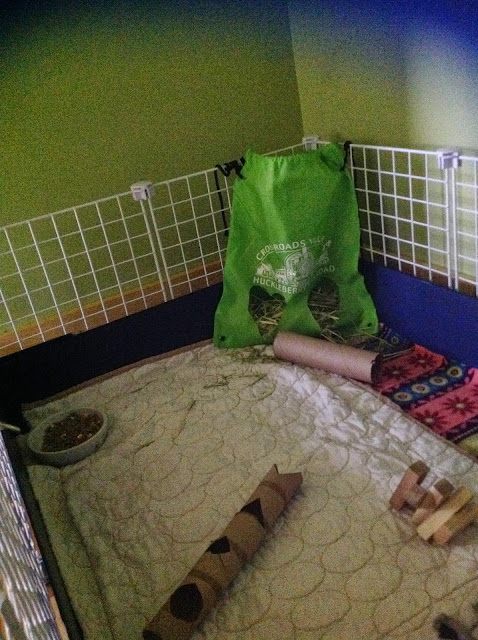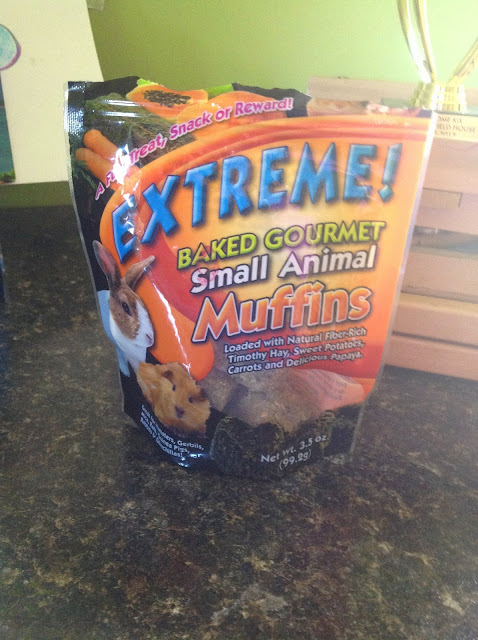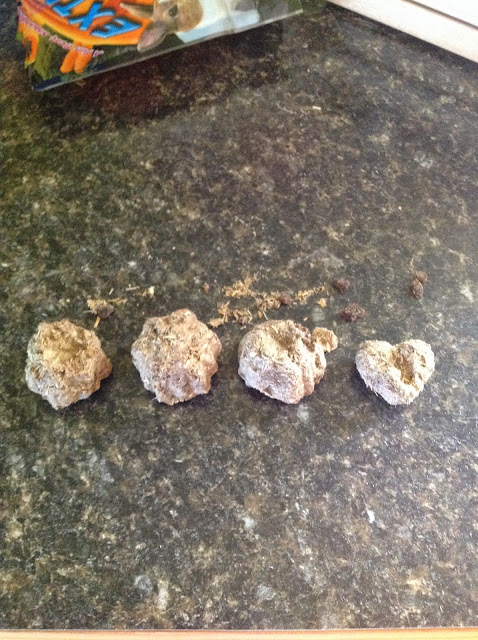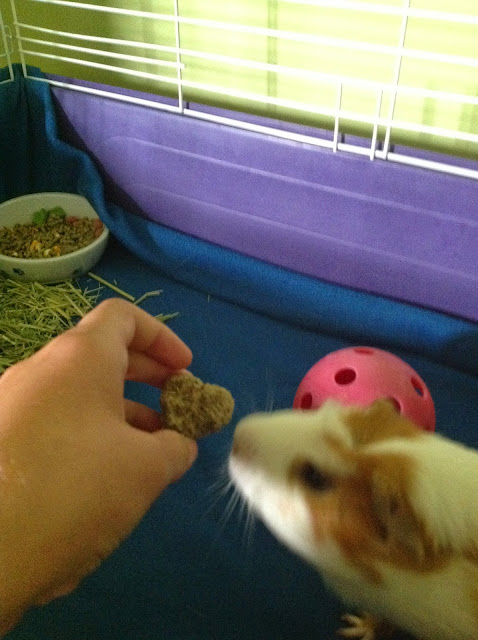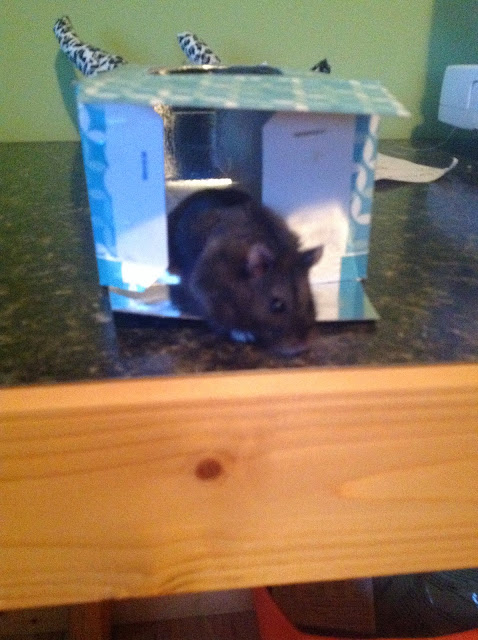Wednesday, September 10, 2014
I got my C&C Cage!
Monday, September 8, 2014
Guinea Pig Treat Review: Brown's EXTREME Baked Gourmet Small Animal Muffins
Saturday, September 6, 2014
Goodbye, Mickey
Friday, August 29, 2014
How to Clean Guinea Pig Fleece
Using fleece in your guinea pig's cage seems dead simple: Buy a few yards of thick fleece, put it in the piggie's cage, and every two days or so, shake/clean it out. Around the third or fourth day, you wash it, and in goes a second piece of fleece. In theory, it seems simple, but actually, it varies among guinea pig owners. Some like it to look super meticulously clean, while others don't mind if the pig gets messy a bit. There is a great overview of the stuff on the GuineaPigCages.com forum, called The Fleece Project: The Study. It covers purchasing, preparing and using fleece.
The Fleece Project recommends a Vacuum-Shake-Brush-Beat routine. I prefer a Brush-Shake-Baby Wipe-Air Dry-Shake routine for cleaning fleece. You probably have (or will have) your own favored routine. As I pull the fleece out of the cage, I sweep much of the debris into the cage with the hand held sweeping brush. All of this brushing often crushes some of the hay, so I find running the dust buster over it briefly can pull off the crumbs and any of the loosened hair. Then I shake the remaining, stubborn bits outside followed by the baby wipe where there's urine. Then I drape it over a patio chair and let it air-dry for a bit, which removes any other hairs or hay bits and makes it less wet.
If the weather is good, I do all of this outdoors, because the hair and hay bits will just blow away. Plus, I don’t have to sweep up the floor when I’m done. Less dust in the house, too. It takes some time and effort, but the results are impressive. You can see the difference with Willow’s fleece.
I have found that thin fleece is better to wick away the urine, and is easier to clean during this process. Polar fleece is downright impossible, but it does absorb well. The reason I use thinner fleece because I only have one pig, but if your guinea pigs are masters at using the bathroom all over the place, or you have a tricky cage base(if it's the kind that absorbs the urine easily) add towels underneath and a puppy pad or two. It takes some time and effort, but the results are impressive. You can see the difference with Willow’s fleece. The prep-work also makes the washing machine (and my mom) a whole lot happier. It doesn’t need to be wiped down after a load of piggy fleece. As an added bonus, if I dry the fleece in the dryer, the lint trap doesn’t look like half a guinea pig was shaved into it. :)
Washing
Even if you use the tecniques described above, your pig's fleece still needs to be washed twice or even three times a week. Pretty much everyone agrees that vinegar is great for removing urine and odor from fleece. Beyond that, laundering techniques can vary as much as the prep-work.
If you pour in about 1/2 to 1 cup of vinegar, a scoop of OxiClean and maybe a drop of detergent with a large load of pig fleece, it gets rid of odors and icky urine stains. Some washers have an extra rinse options, so if yours does, use that and run with warm/cold water (instead of hot). Fleece doesn’t hold onto the water, so you can just leave it out to dry.
That’s my basic cleaning routine. Nothing complicated. I sweep daily with a sweeping brush or the lightly with the rubber mitt. I do the Brush-Shake-Baby Wipe-Air Dry-Shake thing every few days. Fleece that is dry, clean and doesn’t smell may go back in the cage; stuff that needs washing goes in the hamper. I run a load whenever the hamper is full or when I’m on my last set of clean fleece for the cage. Your mileage will vary, based on number of pigs, their habits, humidity, cage setup (including what you use under the fleece) and your personal sense of what’s clean or not.
Willow's fleece: before and after
Sunday, August 24, 2014
Hedgie Body Language
You will be able to tell how your pet hedgehog is feeling from its body language and the sounds it makes. Here are some of its typical responses and what they signify.
Rolling up
Rolling into a ball is a defence mechanism and it means it is frightened or doesn’t like what’s going on around it. Reasons for this could be sharp noises, the smell of a predator or when a person it doesn’t know tries to handle it. Hedgehogs also sleep rolled up in a ball but not as tightly as when it is in its defensive posture.
Raising its forehead spines
Hedgehogs will raise the spines on their foreheads to protect its eyes whenever it is feeling wary or distrustful. It will often raise its spines when you are caressing its back and your hand strays to close to its head. When young hedgehogs play together they always keep their forehead spines raised.
Flat spines
Once your pet hedgehog gets to know and trust you, it will keep its spines flat while you are caressing it. It might take a while longer for it to stop raising its forehead spines.
The flehmen response
When a hedgehog smells something interesting or dangerous it will hold its snout high with its mouth slightly open and its top lip curled back. This behaviour is known as the flehmen response and is also seen in cats and dogs.
Self-anointing
You will sometimes see your hedgehog foaming at the mouth and if you don’t know what’s happening it can be quite disconcerting at first. This behavior typically occurs when it smells something new in its cage or its surroundings. It will sometimes lick or chew the scented object and salivate profusely producing foam. It will then spread the foam over the spines of its back and neck and the hair along its flanks. Nobody is really quite sure why it does this and theories range from it being a way adding a form of toxin to its spines to deter predators, a kind of perfume to attract a mate or a defensive strategy to make the hedgehog blend in with its surroundings.
Sounds
The most noticeable and frequent sound your hedgehog will make is the huffing and snuffling noise you will hear as it searches for food or moves things around in its cage. It will also hiss and make a jumping motion if it disturbed or annoyed. You’ll hear soft grunts or sniffs of contentment as it goes about the important business of feeding. If you hear loud screaming or squeals it means your hedgehog is in severe pain or danger. If you have more than one hedgehog in a cage it may mean they are fighting and they should be separated immediately. Baby hedgehogs make a chirping sound that later turns into a cry which can become loud and piercing if they find themselves separated from their mother. A happy hedgehog will make soft snuffling noises as they crawl all over you but will hiss and huff if they are startled by something while being handled. Hedgehogs will often snore while sleeping and make other noises that may indicate they are dreaming.
Observing your hedgehog
Apart from the typical responses and behavior mentioned above, you’ll also find that your hedgehog will develop its own individual characteristics and quirks. One author reports that one of his hedgehogs learned to stand on its back legs and lean its fore paws against his leg when it wanted attention. If you observe your pet you’ll soon learn about how it is trying to communicate with you and further increase your enjoyment of owning your spiky little friend.
Tuesday, August 19, 2014
Ramps in Piggie Cages
Ramps, Stairs, and Ladders
If your pets' cage is split over several levels, they will need some way of getting up and down between them. Ramps are the best thing for the job, although there are alternatives if you don't have much space. You can also use guinea pig ramps to allow your cavies to get in and out of their cage, and to add interest to a run or playpen.
Ramps
Guinea pigs are most comfortable walking on solid, flat surfaces, so a ramp is the best thing to use if you need to give your animals something to walk up and down. Try to keep the angle as shallow as possible by getting a ramp of a good length - if it is too short and too steep, your pets will have difficulty getting up and down it, and may avoid using it completely.

Many pet stores sell ramps which are made from solid wood. These are ok, but can be a little uncomfortable on your guinea pigs' feet, and you might also find that they can't get enough grip to walk up it properly. You can fix both of these problems by covering the ramp with a soft, grippy material such as carpet, towelling, or rubber.
If your guinea pigs' cage doesn't have much room for a ramp, you can buy or make one which doubles back on itself. This gives the benefits of a shallow angle without taking up lots of space. These are particularly common in hutches which have a built-in guinea pig run underneath.
When buying or making a guinea pig ramp, make sure it has plenty of width. This will make your cavies feel safer and more confident when using it.
Stairs
If your pets have a steep angle to climb, or if you are very pushed for space, you can use stairs rather than a ramp. Guinea pigs are actually quite comfortable using them, and can get up some surprisingly large heights - they can even be taught to climb the stairs in your home! When buying them, make sure that each step is large enough for them to sit comfortably before tackling the next one.
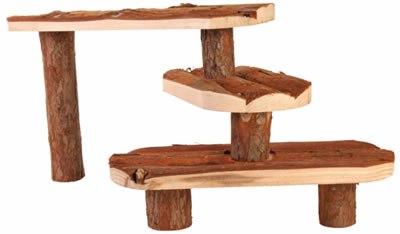
Ladders
Guinea pigs have very delicate, sensitive feet which makes it painful for them to walk on wire mesh ladders, so they should be avoided. They also tend to be far too steep for your cavies to climb, so you will find they won't use them anyway.
Monday, August 18, 2014
Litter-training Piggies - Is it possible?
When new pet owners bring their furry little bundles of joy home, it doesn’t take them long to realize how much poop piggies can produce. This often leaves them asking the question: Can I litter train my guinea pigs? The answer quite simply is yes, but only to a certain extent.
If you want your pigs to only use their litter box and never have accidents when they are out of their cage, then perhaps you are setting your standards too high. Be realistic. If your guinea pig manages to use it’s litter box even just 50% of the time, it will still help keep the cage tidy and reduce your work for cage clean outs.
We’ve all seen the small corner litter trays available at pet supply stores for various sized rodents, and dream that perhaps our piggies, too, could learn to be more ‘accurate’ with where they go. Well, the next time you’re shopping, I suggest you pick one up to try it with your piggies, or try constructing your own.
Both female and male guinea pigs can be territorial and like to scent mark around the cage. Often guinea pigs will choose corners in their cage to go to the bathroom in, constantly returning to the same corner. When you have seen that your guinea pig has chosen a corner, place the litter box in the spot. Put your normal bedding in the litter box before trying any new types of litter.
Steps for Success
- Allow your guinea pigs to scope out their perfect toilet corner, before placing a litter tray in the cage
- Put the litter tray in the corner that the guinea pigs seem to pee/poop in the most
- Fill the litter box with a familiar smelling and looking litter to the one the guinea pigs are currently on
- Wait to ensure that the guinea pigs are content using the same corner before changing the litter
- Change the litter box every three days as needed, and wash it every other week. This ensures that the guinea pigs’ scent is still strong on it, so they will more willingly go back to use the litter box and ‘re-scent’ it.
If all succeeds, your piggie should still be happy to go in his/her chosen corner; but now you can more easily clean it by simply emptying and refilling the litter box. Some guinea pig owners have tried putting food dishes in their litter trays so that as they eat, they will also pee/poop in the same location. This is a conflicting method as many animals avoid urinating and defecating near their food source. As your guinea pig becomes more comfortable with using the litter tray, try using your preferred litter such as Carefresh or Yesterday’s News.
Despite guinea pigs sometimes not seeming to be the brightest, like when they popcorn, they are surprisingly smart and clean animals. So give your guinea pig the chance to try the litter box, and maybe they’ll be happier to use it than you think!



